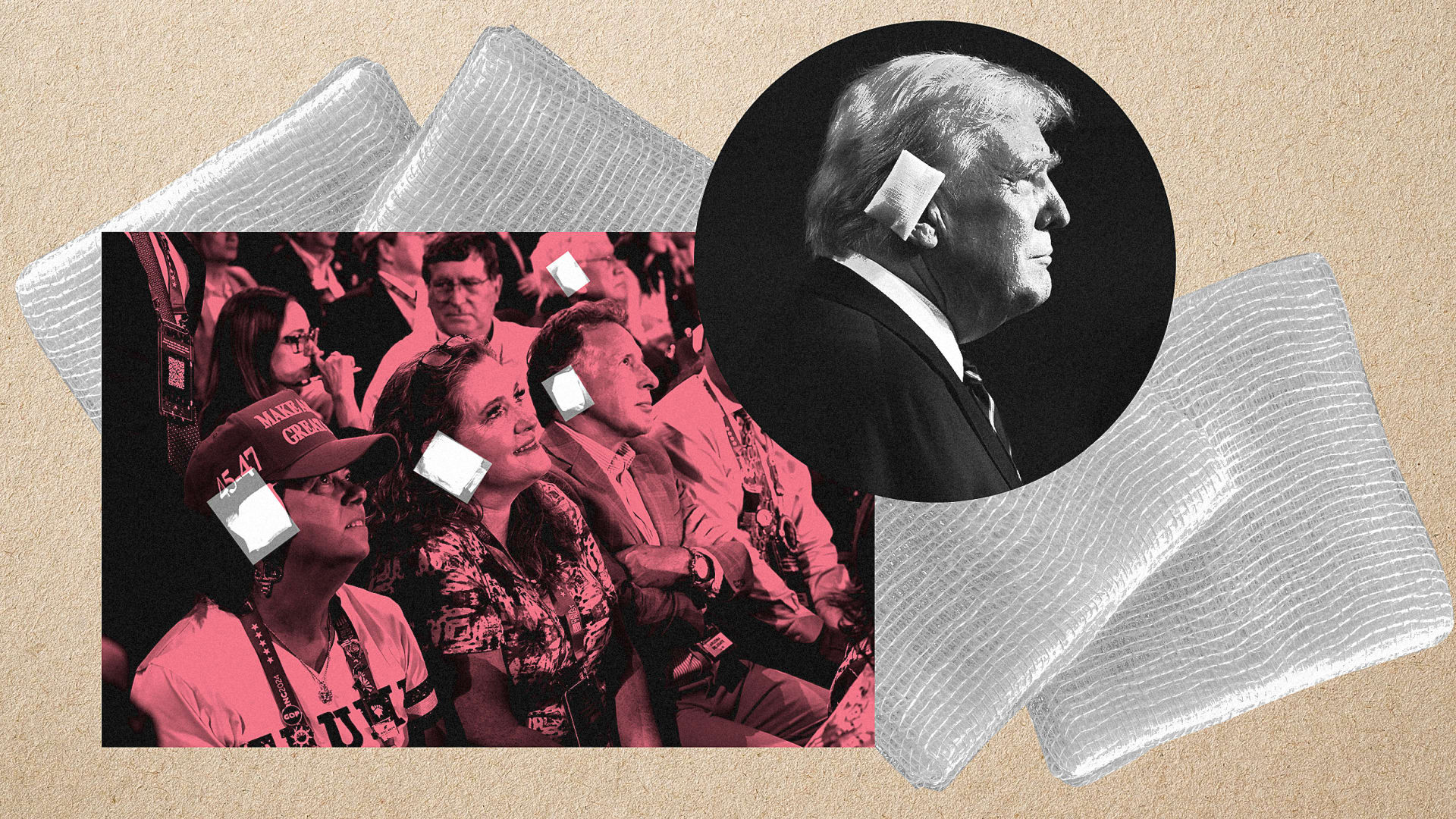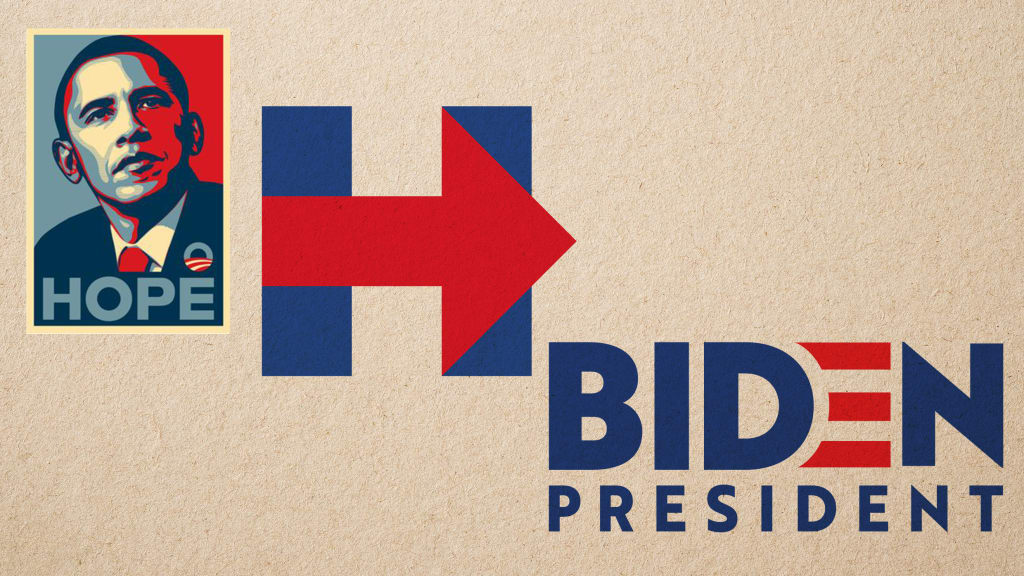From ear bandages to that photograph, Donald Trump’s symbolism has expanded beyond an old red hat.

[Photos: Patrick T. Fallon/AFP/Getty Images, Joe Raedle/Getty Images]
Who would have ever thought that an ear bandage would be the new MAGA hat?
At the Republican National Convention this week, scores of Donald Trump supporters attended wearing a bandage on one ear. To liberals, the site has been fodder for ridicule: Folks in cowboy hats and red, white, and blue smiling, laughing, or near tears, with a bunch of cotton taped to the side of their head in morbid homage to a former reality-show host-slash-president-slash-convicted felon who was nearly killed in an assassination attempt not even a week ago.
But to those wearing the patch, it means something powerful. It’s not a celebration of “You tried to kill Trump and missed.” To them—people worried that they’re losing authority over the world—it symbolizes “You tried to kill us.”
It’s impossible to think of a single contemporary symbol that’s united the left in the same way. In 2016, Trump resurrected Ronald Regan’s MAGA hat. The design was unoriginal, and just ugly enough to be worth talking about, with a message just syntactically strange enough to be memorable. The result was absurdly effective in uniting Republicans under a shared, blindingly red message.
But when Trump dusted it off for his 2020 run, the MAGA hat had grown stale. Everyone knows the sequel has to hit harder, to be bigger and badder than the original, to accelerate the premise to keep the audience’s attention. Trump failed to generate that acceleration in his 2020 campaign, but his 2024 run is shaping up to be one of the most symbolically rich in history.

HOW REPUBLICANS MASTERED MEMES
Republicans’ mastery over icons has been growing as the alt-right has spent the past decade slowly consolidating its base through symbols and codes hidden in plain sight—often appropriating innocuous symbols for nefarious messaging. From Pepe the Frog, once an innocent web comic that became a mascot for far-right ideas, to the “okay” hand gesture, which to some symbolizes white power, the extreme right has packaged hate in both the anodyne and the absurd, leveraging memes to ride the natural virility of the internet. (Feel free to peruse more than 150 such symbols in this database from the Anti-Defamation League.)
Democrats have offered a few successful symbols of their own—perhaps most notable of the past decade is the hand-knitted “pussyhat” that crested alongside unprecedented women’s marches in 2017. Its handmade feel was grassroots to the core. But a pink hat named after slang for genitalia was never going to become a universal symbol to unite the left. Furthermore, it was crafted, not as its own clear statement, but as a response to one of Trump’s most grotesque statements-gone-memes—“Grab them by the p*ssy.”
While liberals used the pussyhat to critique the GOP, they were simultaneously perpetuating Trump’s point of view. The left is superb at critique but lousy at appropriation, and so it attempts to subvert the power of images without taking them for themselves. Case in point: When Trump punched a fist through the shield of Secret Service members, he wasn’t just creating a photo op, he was reclaiming the raised fist itself—the very logo of the Black Lives Matter movement built from its origins in the 1960s Black Power movement. In that moment, Trump said to every civil rights activist in history that this gesture was now his.
I think back to the right’s coining of “Obamacare,” a rightist burn for the Affordable Care Act that Obama simply absorbed and adopted as a compliment. Maybe Biden should have put on a MAGA hat years ago.

WHAT DEMOCRATS STILL DON’T SEE
In more official branding capacities, Democrats have proven inept since 2008, when Obama promised the universal ideal of Hope while looking like a rebel hero screen-printed onto a poster. Hillary Clinton’s logo from 2016 featured an arrow pointing to the right. Biden’s own 2020 logo featured lettering that looked a lot like a hand—at the very time he was being accused of inappropriately touching women. The most Biden ever gave his base was some aviator glasses and “I’m with Joe,” as if one was meant to conclude “I like those shades from Top Gun (1986) so I guess this is the way I’ll vote.”
These critiques might seem superficial, like petty ideas to dunk on via social media—and sure, they are. But they also represent Democrats’ lack of foresight and understanding of internet culture, especially when politics get involved. Memes matter.

No one understands that reality better than Trump. The sharpest I’ve ever seen his eyes was during those moments after a would-be assassin’s bullet grazed his ear at a campaign rally in Pennsylvania. Undoubtedly rattled from the close call, he still knew exactly what he had to do. Photographer Evan Vucci may win another Pulitzer Prize for his photo of the aftermath, in which Trump, topping a pyramid of Secret Service agents, raises a fist while yelling “Fight!” But make no mistake: Vucci was taking the shot that Trump wanted.
Everything about the scene was staged to make Trump look powerful—from Vucci’s low-angle vantage point to the American flag placed in the backdrop just over Trump’s shoulder to the blue jacket that made him look presidential. It produced a photo that will be labeled as political history, though it’s at least equal parts political propaganda.
Like it or not—and gosh, I do not—Donald Trump is an icon. From his orange skin to his pseudo hair to his red hat to his white bandage, he knows exactly how politically valuable an image can be. And Democrats are still mocking that icon, rather than presenting an icon of their own.
Recognize your technological breakthrough by applying to this year’s Next Big Things in Tech Awards! Extended Deadline to Apply: Friday, July 19.
ABOUT THE AUTHOR
Mark Wilson is the Global Design Editor at Fast Company. He has written about design, technology, and culture for almost 15 years More
No comments:
Post a Comment